We stayed in Santiago de Cuba for six days. It was such a bustling place that we were quite exhausted about halfway through our stay.
I don’t believe I mentioned that after we were cleared in with the health official from customs, we moved Pandora into the part of the harbor for pleasure boats. As we were getting ready to take the health official back to shore and go to the custom’s office for our interview, we noticed some young men calling to us from shore. We both waved to them all, and that seemed to be some kind of signal for all of them to jump in the water. I swear they were swimming out to us! We quickly locked up the boat in case they were planning to board while we were ashore. Once ashore we asked the customs official about them, but he said they were harmless.
We already knew that no Cuban may go onboard a private boat without written permission from some government bureau issued 24 hours in advance. I did not think these young men would board our boat right in front of customs and immigration officials. But shortly after we sat down in the customs office one of the officers came in and asked Bob to escort him out to our boat in our dinghy so he could scare off the young men (they ranged in age from teens to early 30s). He assured Bob that they meant no harm and most likely would not actually get on our boat. But they had surrounded the boat at this point, and a couple of them were climbing the anchor chain. I was very glad to realize it was Sunday and at least for the next few days they should all have to go to school or work.
Drivers and taxis are quite an experience. On the one hand there is an official fare that cannot be changed so you will always pay the same fare for the same route. In our case, that was to and from the marina and the center of the city. Noel was recommended to us as a good driver with excellent English. Many people who work with tourism want to have lots of practice with their English. A few English people come here, but not enough to help the locals practice on a regular basis. So any English speaking people are popular targets. Noel really was as good as his reputation. Other taxi drivers get $10 each way (and remember this is $20 each way for us since we had Canadian money) to pick up or deliver people to the marina which is well outside the city. Noel would spend time with us after getting into the city, waiting for us at the Cadeca to exchange money, taking us to the large local produce market where he changed our tourist pesos (CUCs) for local pesos and then helped us pay for our goods!
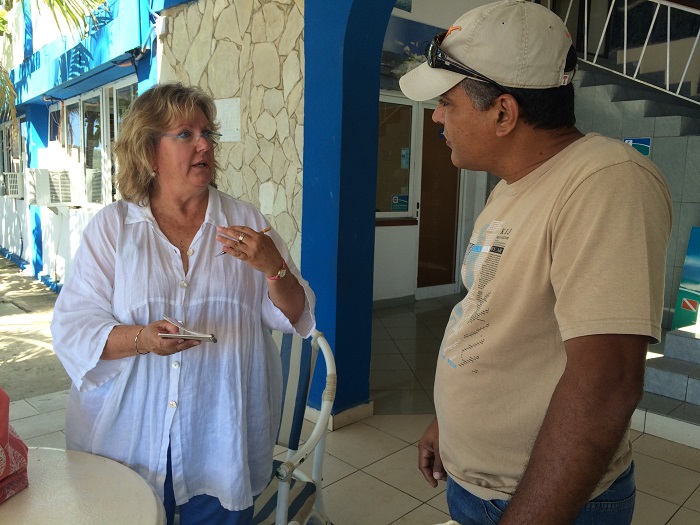 Yet there was a downside. The first day we used Noel he helped we arranged for him to come back at a certain time to pick us up. He gave us his mobile number and told us to ask any Cuban on the street to make the call. When we did that later, Noel told me he was not free to come get us. His transmission had malfunctioned and his car was not drivable. Okay….time to try a local taxi. It all went fine. It was just a hassle to brave the phalanx of taxi drivers at the Parque Cedespedes to get one. Each taxi has two men: one to walk the streets hawking you to take his taxi, and one who stays with the car and is actually the driver. There is a sea of the taxi hawkers and it’s a bit overwhelming to try and approach one while at least 10 others are vying for your business. I know they don’t get into fights over it, but it looks like they come just shy of fighting for customers.
Yet there was a downside. The first day we used Noel he helped we arranged for him to come back at a certain time to pick us up. He gave us his mobile number and told us to ask any Cuban on the street to make the call. When we did that later, Noel told me he was not free to come get us. His transmission had malfunctioned and his car was not drivable. Okay….time to try a local taxi. It all went fine. It was just a hassle to brave the phalanx of taxi drivers at the Parque Cedespedes to get one. Each taxi has two men: one to walk the streets hawking you to take his taxi, and one who stays with the car and is actually the driver. There is a sea of the taxi hawkers and it’s a bit overwhelming to try and approach one while at least 10 others are vying for your business. I know they don’t get into fights over it, but it looks like they come just shy of fighting for customers.
Due to Noel’s transmission problems, the next day we used a ‘friend’ of Noel to drive us into the city. He did not speak one word of English so it was too difficult to do any of the shopping we had hoped to do. Anyway, I spent at least half the day at the Women’s Federation, so it didn’t mater that much.
Meanwhile, Noel dealt with his transmissions problems, not by taking his car to a garage….there aren’t such services here. He hunted around for a part off another car that would do the trick. It certainly didn’t have to be from the some make of Czech Rebublic car either. The part he found did not fit his car so he just drilled new holes in it to make it fit. I wonder how many times that happens before your car is no longer sound due to having so many holes drilled in it?
On day three, Noel was back in business. He offered to take us to a Cadeca again, to a bakery and then to lunch overlooking the harbor and then to the Castillo de Morro—a perfect plan for a beautiful day! He had our jerry jugs for diesel in his trunk, and at the end of the day would take us to a gas station to fill them. But we were barely out of the marina and still outside the city when a policeman pulled us over, and in checking Noel’s papers found that his license was 15 days expired. Noel said that he has 30 days to renew, but clearly that is not what the policeman thought. He allowed Noel to drop us in the city, but then Noel was required to go immediately to the police station. So there went our carefully planned day.
Fruit at the large market
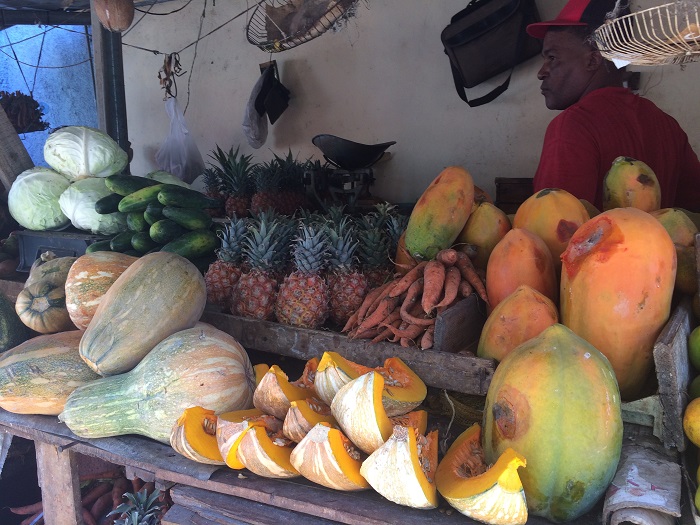 At the end of the day Noel returned, but still without the proper papers so he was not allowed to have us as passengers in his car. He brought a friend (no English!) to drive us to the bakery and to a gas station, but not out to Castillo de Morro that we’d been looking forward to seeing. Noel was very insistent that he keep the jerry cans in his car, while his friend drove us. I think he wanted to keep us as his customers rather than loosing us to his friend. Anyway, these predicaments seem to be the fabric of life for the Cubans. Noel was not put out at any time over his car problems or his license. He said this is just the way it is in Cuba.
At the end of the day Noel returned, but still without the proper papers so he was not allowed to have us as passengers in his car. He brought a friend (no English!) to drive us to the bakery and to a gas station, but not out to Castillo de Morro that we’d been looking forward to seeing. Noel was very insistent that he keep the jerry cans in his car, while his friend drove us. I think he wanted to keep us as his customers rather than loosing us to his friend. Anyway, these predicaments seem to be the fabric of life for the Cubans. Noel was not put out at any time over his car problems or his license. He said this is just the way it is in Cuba.
A very odd situation cropped every day when we arrived in downtown Santiago. Men would approach us and say that they recognized us from the marina. These were people we had never seen before! Some men would even say they knew we were on the ‘dark green boat.’ The first man who did this really conned us. I wrote about him in the first post about Santiago de Cuba. He said he recognized us because he was on duty in the customs office when we checked into the harbor. Believe me, I was so nervous and enthralled by that first check in to this forbidden country, I would have remembered him…yet I didn’t. Still, he was very convincing. The paladar he took us to was more expensive than any other place we’ve eaten during our entire stay, although it was very good. And, since we walked past the custom’s office every time we got off the boat, we realized that the man who took us on this little farce has not turned up there during our entire stay.
How could so many people know about us? The marina was a long way from the city center—15 -20 minutes by car. It felt like there was a pipeline of information being passed around about each tourist. And I can only imagine in a country where ‘one hand washes the other,” and “who you do and who you know” might mean that everyone involved got a little piece of the pie.
Also, I think I might have indulged in one too many ice cubes. I seem to be a bit under the weather and experiencing a general malaise. Bob is feeling a bit less than stellar as well. We have each indulged in a couple of lemonades and mohitos during our stay, in spite of my determination not to have anything with ice. Ah well…
So we are now spending a couple of days in a small harbor called Chivirico, a few miles to the west. It was quite a leap of faith to get in here, following the waypoints that Frank Virgintino gives in his guidebook—though we think his final waypoint is a mistake. All went well. We had to navigate through a very narrow cut between two coral reefs, with breaking water on both sides of us (that’s a sure sign that the water is very shallow! And coral reefs are very sharp and dangerous!). Once in the tiny harbor, in calm water, it felt like we’d really accomplished something to arrive here.
Wouldn’t you know that within the first hour of arriving we were barraged by a gaggle of young boys who swam out from where they’d been playing along the shore. One boy was bold enough to begin climbing up onto our swim platform at the stern. But the moment Bob said, NO, you don’t!” the boy slid back into the water and shortly after they all swam back to shore. In spite of knowing that this is a very friendly culture with a social distance much closer than I am used to, I still can’t help being a bit unnerved by all this…what to call it? Exuberance? Opportunity? There is very little privacy! …even in such a small harbor!
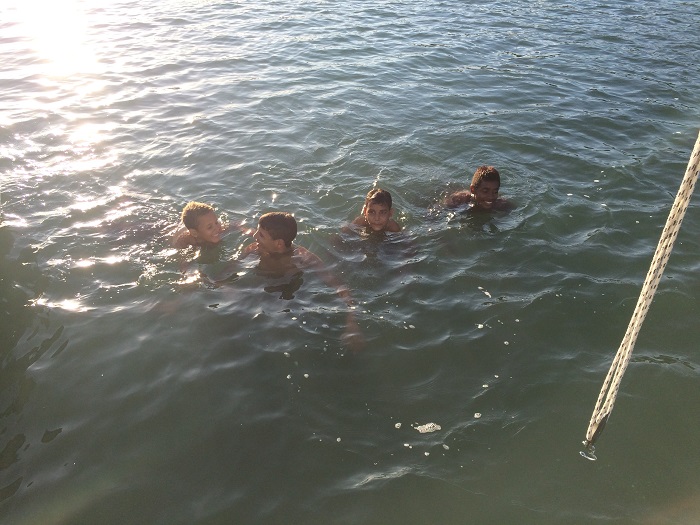 We had a relaxing late afternoon and evening watching men fishing with hand lines from the shore, watching the same group of boys jump from a tree into the water, and some men in dories throwing round nets. There were men who worked in groups to stretch gill nets or seine nets completely across the entrance to this harbor. It was a lazy Sunday afternoon for us and for the boys, but not for the men, and likely not for the women either.
We had a relaxing late afternoon and evening watching men fishing with hand lines from the shore, watching the same group of boys jump from a tree into the water, and some men in dories throwing round nets. There were men who worked in groups to stretch gill nets or seine nets completely across the entrance to this harbor. It was a lazy Sunday afternoon for us and for the boys, but not for the men, and likely not for the women either.
Late at night while we were watching the stars a boat arrived flying the Norwegian flag. There was no way to signal them about the nets, but they seemed to enter the harbor easily and left just as easily just after dawn this morning. I have no idea when the men might have taken down those nets! We did not see them do it.
There is always some chore that needs doing on a boat, just like at home. During the past few months our sail cover, which protects the sail from damaging UV rays, has starting to deteriorate. Just like the sail itself, it is also affecting by UV rays, and the stitching that it was sewn with has come apart in places. No problem for Bob, who brings his heavy duty sailrite machine with him everywhere we sail. Here he is with the sail cover spread all over the foredeck, mending away.
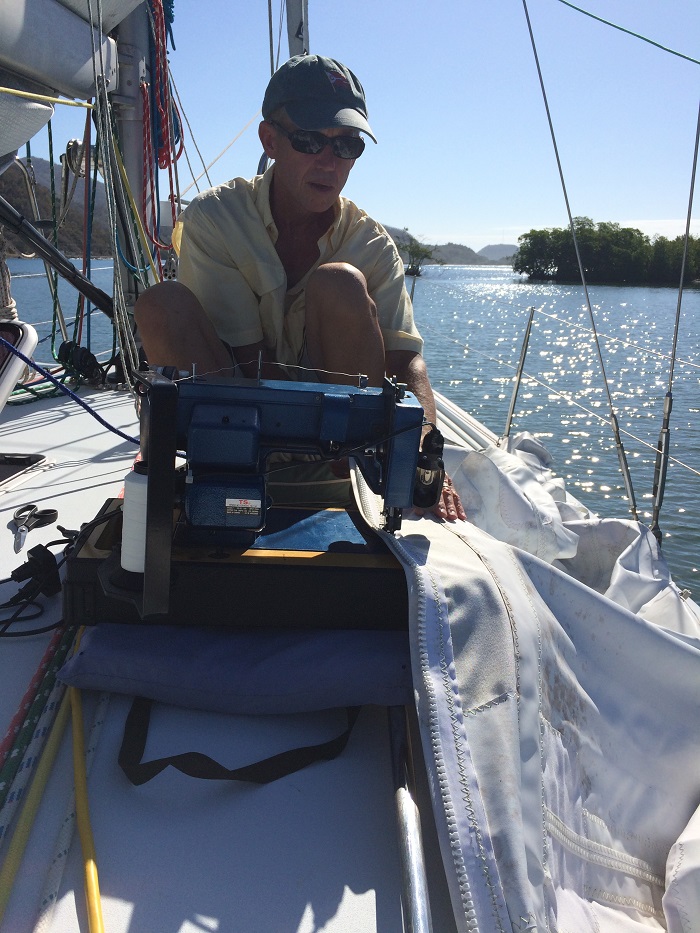 Here is Pandora sitting pretty in Chivirico.
Here is Pandora sitting pretty in Chivirico.
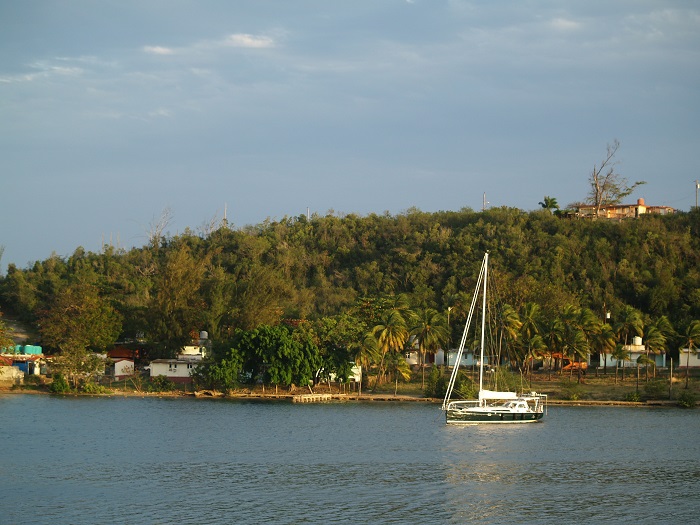 As I write this I am high up on a bluff in Chivirico called Hotel Brisas. It is a stunning spot, and hopefully we will have photos by te next time I post. We are here for the internet and some lunch.
As I write this I am high up on a bluff in Chivirico called Hotel Brisas. It is a stunning spot, and hopefully we will have photos by te next time I post. We are here for the internet and some lunch.
There is a charming town here in Chivirico that looks like it was frozen in time during the early 20th century. Plenty of old cars here, but even in more abundance are mule drawn carts. From the boat we can hear the clop-clop of their hooves as they trot through the streets. People here have tidy little houses with immaculate gardens. The shop fronts along the main street are also very charming and neatly kept. I´m looking forward to buying some Cuban coffee when we leave here in a bit.


